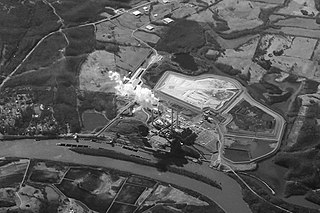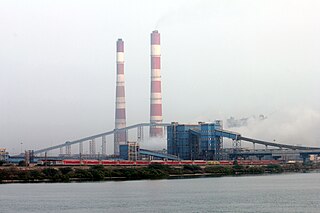
Flue-gas desulfurization (FGD) is a set of technologies used to remove sulfur dioxide from exhaust flue gases of fossil-fuel power plants, and from the emissions of other sulfur oxide emitting processes such as waste incineration, petroleum refineries, cement and lime kilns.

A fossil fuel power station is a thermal power station which burns a fossil fuel, such as coal, oil, or natural gas, to produce electricity. Fossil fuel power stations have machinery to convert the heat energy of combustion into mechanical energy, which then operates an electrical generator. The prime mover may be a steam turbine, a gas turbine or, in small plants, a reciprocating gas engine. All plants use the energy extracted from the expansion of a hot gas, either steam or combustion gases. Although different energy conversion methods exist, all thermal power station conversion methods have their efficiency limited by the Carnot efficiency and therefore produce waste heat.

The Richard L. Hearn Generating Station is a decommissioned electrical generating station in Toronto, Ontario, Canada. The plant was originally fired by coal, but later converted to burn natural gas. The plant has been described as "Pharaonic in scale", and encompasses 650 thousand cubic metres of space—large enough to fit 12 Parthenons inside.

Duke Energy Corporation is an American electric power and natural gas holding company headquartered in Charlotte, North Carolina. The company ranked as the 141st largest company in the United States in 2024 – its highest-ever placement on the Fortune 500 list.
The Keystone Generating Station is a 1.71-gigawatt, coal power plant located on roughly 1,500 acres (610 ha) in Plumcreek Township, southeastern Armstrong County, Pennsylvania near Crooked Creek, just west of Shelocta, Pennsylvania.

Cumberland Fossil Plant is a pulverized coal-fired power station located west of Cumberland City, Tennessee, US, on the south bank of Lake Barkley on the Cumberland River. Owned and operated by Tennessee Valley Authority (TVA), it has a gross capacity of 2,470 MW, and is the most powerful power station in Tennessee.

The W. H. Sammis Power Plant was a 2.23-gigawatt coal power plant in Stratton, Jefferson County, Ohio. The plant was operated by Energy Harbor. It began operations in 1960.

Orot Rabin is a power station located on the Mediterranean coast in Hadera, Israel which is owned and operated by the Israel Electric Corporation (IEC). As of 2022 it is Israel’s largest power station and contains six thermal generation units capable of producing a total of 2.59GW of electricity using coal as the primary fuel. In addition, under construction at the site are two single-shaft natural gas-powered combined-cycle units capable of generating 630 MW each. The older, unmodernised four of its total six coal-fuelled units will be closed by mid-2022 in order to eliminate this major source of air pollution in the country.

Bull Run Fossil Plant, commonly known as Bull Run Steam Plant, is a retired 889 megawatt (MW), coal-fired electric generating station owned and operated by the Tennessee Valley Authority (TVA). The plant is the only coal fired power plant ever constructed by TVA with one unit, and was retired on December 1, 2023.

The Lingan Generating Station is a 620 MW Canadian coal-fired electrical generating station located in the community of Lingan in Nova Scotia's Cape Breton Regional Municipality. Lingan is operated by Nova Scotia Power Inc. and is their largest generating station.

The A. B. Brown Generating Station is a four-unit, 700 megawatt (MW) power plant, located on the northern bank of Ohio River, 8 miles (10 km) east of Mount Vernon, Indiana and 5 miles (8 km) southwest of Evansville, Indiana just west of the Posey-Vanderburgh County Line. Each of the two coal-fired units has a name-plate capacity of 265.2 MW. Bituminous coal is used as a primary fuel type, which can be substituted for natural gas. There are also two gas turbine units, 88.2 MW of nameplate capacity each. The facility is owned by Centerpoint Energy. Vectren announced a plan to retire the plant in 2023 and replace it with a natural gas power plant; however, this plan needs to be approved by the Indiana Utility Regulatory Commission.

The Saint Clair Power Plant was a major coal- and oil-fired power plant owned by DTE Electric, a subsidiary of DTE Energy. It was located in St. Clair County, Michigan, on the west bank of St. Clair River. The plant was across M-29 from the newer Belle River Power Plant in East China, Michigan. The first four units of St. Clair were built in 1953–1954. Since then, three more generating units were added to the plant. The St. Clair Power Plant generated 1982 megawatts in total. It was Detroit Edison's second largest power producer. The power plant has a large impact on the local economy, employing about 300 workers. The plant shut down in May 2022.

Kilroot power station is a fossil fuel power plant on the north shore of Belfast Lough at Kilroot near Carrickfergus in County Antrim, Northern Ireland. The plant currently has a 141 megawatt (MW) capacity from four standby gas turbines and a 10 MW battery energy storage capacity from the Kilroot Advancion Energy Storage Array.

John E. Amos Power Plant is a three-unit coal-fired power plant owned and operated by Appalachian Power, a subsidiary of American Electric Power (AEP). With a nameplate rating of 2,933 MW, it is the largest generating plant in the AEP system. It was named after John E. Amos, a prominent state senator, Democratic National Committee member from West Virginia, and member of the AEP board of directors.

Brunner Island Steam Electric Station is a coal-fired, alternatively natural gas-powered electrical generation facility in York County, Pennsylvania. It occupies most of the area of the eponymous island on Susquehanna River. The power plant has three major units, which came online in 1961, 1965, and 1969, with respective generating capacities of 334 MW, 390 MW, and 759 MW. In addition, three internal combustion generators were installed in 1967. Talen Energy will stop coal use at the plant in 2028.

The Rutenberg Power Station is a coal-fired power plant situated on the Mediterranean coast in Ashkelon, Israel.

The Shawnee Fossil Plant is a coal-fired power plant owned and operated by the Tennessee Valley Authority, located near Paducah, Kentucky. The closest city is Metropolis, Illinois, across the Ohio River to the northeast. The Shawnee Fossil Plant was created with the intentions of providing sufficient electricity to the national defense industry escalating demand for power which could not be met with the Commonwealth of Kentucky's then-current infrastructure. The plant also provided economic growth to the area in the post-WWII era creating jobs and a stronger infrastructure to support future state developments.

Vallur Thermal Power Station is a power plant located in Vallur, Thiruvallur district, India. The power plant is operated by NTPC Tamil Nadu Energy Company Limited, a joint venture between NTPC Limited and TANGEDCO and has three units with 500 MW each.

The W.A. Parish Generating Station is a 3.65-gigawatt, dual-fired power plant located near Thompsons, Texas. The station occupies a 4,664-acre site near Smithers Lake southwest of Houston in Fort Bend County and consists of two four-unit plants; one natural gas and the other coal. With a total installed capacity of 3,653 MW, it is the second largest conventional power station in the US, and supplies about fifteen percent of the energy in the Houston area. NRG Energy owns and operates the plant.
R.E. Burger Power Station was a 568 megawatt (MW), coal power plant located south of Shadyside, Ohio in Belmont County, Ohio. The plant closed in 2011. It was operated by FirstEnergy.


















